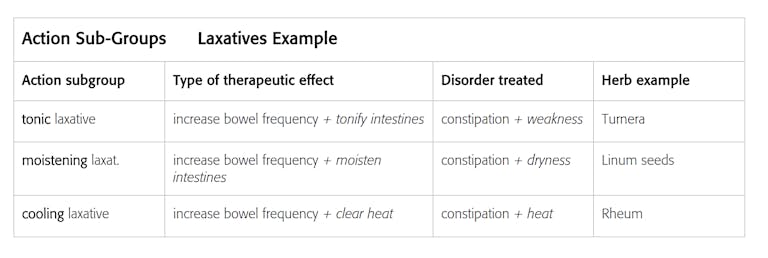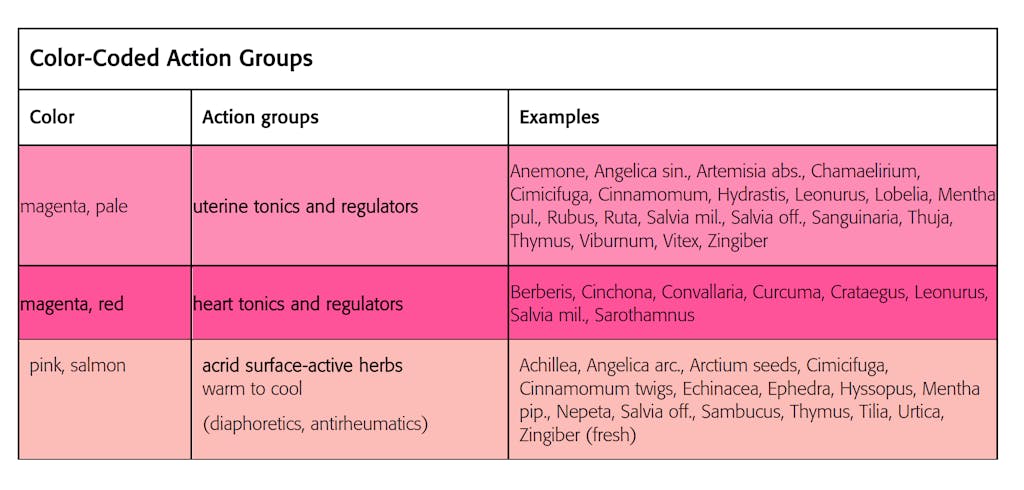Lesson 5: Balance HERB ACTIONS in a herbal combination
The action of a herb refers to the type of therapeutic effect that it has on the body.
Action groups
Herbs that all have a specific action are said to belong to the same action group. Three examples are shown in the Table below.

Action subgroups
Each action group can be divided into subgroups, with the name of the subgroup indicating the specific type of syndrome that the subgroup treats.
Example: constipation in Western herb tradition
A patient with constipation can be given a herb with laxative action. But there are different types of constipation, and laxatives are chosen to the action subgroup

Three action classifications
The names of the action groups, and the way that they are divided into action subgroups, reflect the theoretical principles of the medical paradigm to which they belong.
Three main action group classification systems are considered here:
- Chinese tradition eg. herbs that release Exterior
- Western tradition eg. circulatory stimulants
- modern pharmacology eg. calcium channel blockers
Color-coded action groups
Only a small part of the Table is shown below, as an example, because the full Table is in the database. The color-code used in the Table is used to divide combinations into their component herb units: single herbs, pairs, and trios for easy viewing.
Herbs can have more than one action
Since herbs can have more than one action, the same herb may occur in more than one category, depending on its role in the particular combination.
Example: Plantago is color-coded:
- medium green-blue when used as a cooling astringent
- medium violet-blue when used as a cool anti-inflammatory
Primary and secondary actions
In the Table below, a herb is only entered in a particular action group if the action is primary for that herb.
Example
- Angelica sinensis is shown in the ‘uterine regulator’ group, since this is a primary action for that herb
- Angelica archangelica is not, since this action is only of secondary importance for that herb

Range of potential actions
Usually, herbs do not have just one action: they have a range of potential actions.
Achillea as an example
This herb has a variety of different active constituents, resulting in many different actions, among them:
- antiviral
- antibacterial
- anti-inflammatory
- immunomodulatory
- bitter digestive tonic
- choleretic
- hepatoprotective
- diaphoretic
- antipyretic
- anticatarrhal
- alterative
- astringent
- hemostatic
- diuretic
Which actions manifests in a particular situation?
- depends on the patient’s condition
- eg. unless there is a fever, anti-inflammatory and antipyretic actions may be minimal
Primary and secondary actions
For some herbs with multiple potential actions, one action may be dominant in most situations.
Example: Capsicum
The circulatory stimulant action is usually of primary importance.
For herbs with multiple potential actions, four factors determine which actions are of primary and which of secondary importance in a specific situation:
- herb itself
- context of a specific patient’s condition
- context of a specific herb combination
- dose and herb number
- dispensing method
We can take Dose as an example: If the practitioner wants a specific action to be the primary action in a herb combination, then:
- herb or herbs with that action can be used in higher doses than herbs with secondary actions
- more herbs with the chosen action can be included in the combination
Example: The practioner wants the circulatory stimulant action to be primary in a combination, then the following changes can be made.
Original prescription

New prescription Practitioner increases dose of circulatory stimulants, and number of circulatory stimulants.

Dispensing method
We can look at dispensing method as another example. In some situations, the dispensing method can determine which action is primary and which are secondary.
Achillea as an example
Hot infusion If Achillea is taken as a large volume of hot infusion, this will emphasize the diaphoretic action.
Room temperature decoction: But if Achillea is taken as room-temperature decoction, then other actions may be primary, for example the anti-hemorrhagic action.
